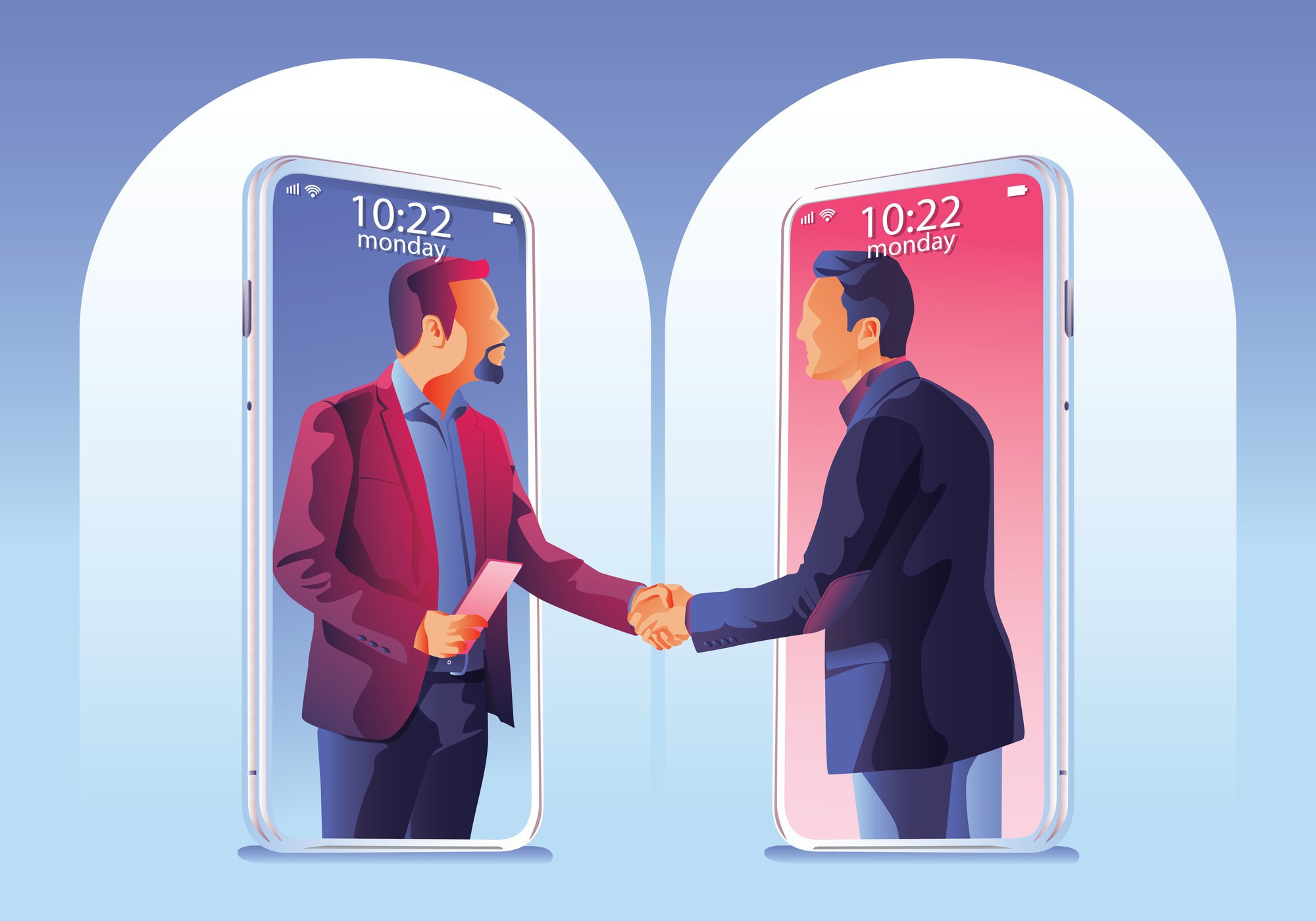The Latest B2B Marketing Trends Breakdown
Marketing a product or service to a consumer is very different from marketing to a person buying for a business. This is Lesson #1 in B2B marketing. But it’s also dangerous to assume all B2B buyers are company drones that only want savings. Buyers will listen with interest to a well-told story just as avidly as any consumer. And just like anyone else, they will usually respond favorably to a solution tailor-made for their problem. B2B buyers are certainly particular purchasing agents, but they are still at the end of the day shoppers like any other. If you’re having trouble winning them to your cause, they're them who’s the problem. It’s you. You need to make your story and sales presentation relatable to your prospective B2B buyer just the same—and make sure you’re in touch with the latest B2B marketing trends.
Closing a B2B Sale Is Different From Closing a Retail Sale
Admittedly, closing a B2B sale is a far more complicated process than just selling to consumers directly. Your competitors probably sell the same items you have, just under a different brand. Meanwhile, other companies will be chasing the same pitches as you, but down different avenues, positioning those pain points from radically different angles. Some rivals might offer better after-service deals, or throw in free maintenance.
Getting past these challenges requires understanding your market, knowing your rivals and having unshakeable faith that your company can solve your clients’ problems best. It also means keeping your team ahead of the curve when it comes to recognizing and adopting B2B marketing trends.
Challenges In B2B Marketing and the Trends That Help Address Them

The field is already crowded enough, but add the nuances of internet marketing to the mix, and the challenges feel insurmountable. In a congested market made even more cramped by the internet, getting noticed must be a priority. Product is important, obviously—but don’t just focus on what you’re selling. Buyers can do their own research and won’t hesitate to ask questions. Before diving into your sales pitch itself, make sure you’ve already tackled the tonal challenges of how to pitch.
Get Heard Among the Noise
The internet is The Great Equalizer for buyers and sellers alike. Sellers are tapping into previously unknown or inaccessible markets. Meanwhile, buyers are much more savvy, able to look into a prospective supplier’s profile and check reviews online. Creating an online presence is the bare minimum in modern B2B marketing. The challenge is making your presence felt. How can you generate attention amid the noise and clutter of the web?
Celebrate Your Difference
In order to generate attention to your particular brand, stop and consider: what makes you different from the rest of the field? Can you pinpoint your brand differentiator? More importantly, does your differentiator solve problems for clients? If the answer to all three is “Yes,” you’ve got a good start. If it’s a “No” or unclear, buckle up, because you’ve got a lot of market research ahead of you.
Consider a Different Buyer’s Journey
The new buyer’s journey is a radical departure from before when vendors could easily source contact information to snag new clients. Nowadays, engaging clients often means sending out mass email flyers on a regular, consistent basis. Vendors also have to dive into websites and apps where they know their target markets hang out and distribute advertising there.
However, this type of outbound marketing depends mostly on the laws of average to succeed. B2B features a more discerning buyer base, coupled with a concentrated community of sellers. These particular tactics might not work as effectively for B2B as for B2C. But the point remains: whether B2C or B2B, the buyer’s journey has changed.
Work On Lead Generation
Similarly, generating leads for B2B sales is not as easy as gathering names for B2C endeavors. There are far fewer company buyers compared to the individual customer market. Many buyers will also often require vendors to show a little loyalty by not dealing with their competitors, slimming the pool even further. Generating B2B leads takes more effort than just rounding up names and numbers.
B2B marketing is no walk in the park. While one deals with fewer clients, the requirements are far bigger and more complex. Landing a B2B account requires more prep work: in-depth market research and above-average presentation skills.
However, bear in mind that the payoff is also substantially larger than easy, small B2C wins. If you can stick the landing the rewards will almost always prove worth your additional effort.
Keep an Eye on These New B2B Marketing Trends
Part of the prep required to maximize your B2B marketing strategy is to stay on top of emerging trends. B2B buyers favor vendors who know how to meet their specific needs and fit their existing systems. Presenting your company as an emphatic, reliable and supportive potential partner can go a long way in courting your buyer and winning their trust. What better way to show your understanding of the market than by staying as current as possible with the latest trends?
Below are ten B2B marketing trends defining business today:
Data-Driven Campaigns with Advanced Analytics

Sales and marketing campaigns will always live or die by the sales numbers. How many buyers saw themselves as beneficiaries of your product?
But as we’ve mentioned, B2B sales aren’t as straightforward as retail purchases, where the buyer can and will buy on impulse—or similarly (and more frustratingly) walk away and abandon a shopping cart on a whim. Getting a B2B sale means thoroughly fine-tuning every detail for a more sustained pitch to convert the buyer.
Analytics as a concept isn’t terribly new among B2B marketing trends. It’s common sense to use statistics to drive campaigns. However, advances in machine learning and artificial intelligence (AI) are leading to remarkably deep insights on buyer behaviors based on how they react to content. Marketers and sales teams can now gather detailed information such as time spent on content and which part of the content generated the most interest, revolutionizing the specificity with which you can assemble campaigns.
Making Analytics Work To Improve Marketing Materials
Analytics help pinpoint both strong and weak points of your message when creating marketing materials. We’re not just talking about social media analytics, where engagement is easily measured in likes, shares or comments. Modern analytics measure every detail of user responses, allowing you to construct a picture of the potential “how” and “why” of the engagement and act accordingly. This includes gathering feedback on pricing strategies, brand/product loyalty, customer responsiveness and sales lead quality.
Analytics can help measure data such as how much time users spend on each section, giving content creators better insights. Page or section views and view duration data can precisely point out which parts of the content work and which need improvement. To learn more about how analytics work to help improve the development of presentation and marketing materials, visit Ingage.
Create Meaningful Customer Relationships With Hyper-Personalization

Effective B2B sales require a thorough knowledge of your customer. While there is (rightly) much focus on just your customer’s wants and needs, to truly develop a meaningful continuous business relationship, you will need to get a bit deeper. You need to actually get to know your customers and the nature of their business.
In simpler times, personalization might have just meant writing your client’s full name on the envelope containing your offer. As things moved to digital, perhaps your efforts evolved into a personal greeting whenever a client logs into your sales portal. But other than a standard recognition of the login name or email, and maybe a list of the last few purchases, B2B vendors have nothing to make the customer stand out.
A hyper-personalized effort means recognizing this problem and diving deep into your customer’s thought process when purchasing. When crafting presentations to specific B2B clients, you need to know them inside and out. The more these presentations get tailor-made for specific buyers, the more they get the impression that you understand them better.
Hyper-personalization Means Highly Customized Content
Hyper-personalization also relies on data analytics—specifically AI and machine learning - to track and predict behavioral patterns in customers. Armed with this knowledge, content creators can then develop highly personalized content aligned to behavioral data. A hyper-personalized presentation incorporates sections aligning with customer’s purchase tendencies. It highlights sections that address your customer’s pain points and matches them with solutions that show how your product or service will solve their unique problems.
In other words, let customers know how much you know about them. Sales presentations and marketing materials that show your awareness of your buyer’s situation better convinces them that your solutions are tailored to fit their problems. Instead of producing the same generic content for all customers, creating hyper-personalized materials for individual clients can spell the difference between closing a sale and getting the door closed on you.
Deliver Effective Account-Based Marketing Through Personalized Presentations

One of the more recent B2B marketing trends spawned out of the recent pandemic. It’s no secret that COVID-19 has changed the way B2B buyers and vendors interact. Where product pitches once involved traveling salespeople and lots of face time with the buyer, now more than 75% of buyers and sellers prefer digital interactions over face-to-face encounters. Even as governments slowly lift lockdowns, it seems the preference to keep encounters virtual instead of physical remains.
But while currently, safety is the primary driver of remote work, it’s not the only reason. Buyers can gather information, initiate transactions and complete purchases easier online. Online transactions take less time and require less effort to complete. Traditional “boots on the ground” field-sales models are slowly becoming obsolete—it’s time to prep some compelling online presentations instead.
Online Presentations Can Effectively Gather Customer Feedback
The shift to online sales and presentations cuts out a lot of the middle-man steps of traditional sales. For example, why make unnecessary client calls to pitch when sellers can simply email a link to a company introduction instead? Presentation software like Ingage has built-in features to help assess how a prospect responds to an initial reach-out presentation. Ingage can determine if the client showed interest in the material and even which particular sections left the most impressions. This is usually measured by the length of time spent on each page or slide.
With these detailed resources and saved time, vendors can create more hyper-personalized presentations to convert leads into fully-fledged customers. Ingage’s analytics reports can help you gather the insights needed to create custom proposals.
Get Marketing and Sales to Work Together and Improve Buyer Enablement

Collaboration between sales and marketing teams isn’t always a given. In the Outfunnel 2021 Revenue Marketing Report, less than half (45%) of companies surveyed described alignment between sales and marketing as “very good” or “excellent.” In fact, 54% of companies with 50-100 employees rated their sales-marketing alignment as “poor,” “fair,” or “good.”
Revenue depends heavily on the relationship between sales and marketing. The same Outfunnel survey reported that revenue growth is 70% more likely for companies with excellent sales and marketing collaboration. The report also underscores the importance of sharing tools. Nearly half of respondents (47%) said sales tech and marketing tech tools are more useful if they can be easily integrated.
Can Marketing and Sales Coexist?
The short answer is yes. Many companies manage to steer their sales and marketing teams to travel in the same direction. And when they do, it’s not only revenue numbers that benefit. A healthy alignment between sales and marketing teams also yields:
- Improved Lead Quality. If marketing and sales can’t align in defining lead requirements, both teams will spend countless hours and ungodly sums of money chasing dead-end leads. Then the blame game ensues: sales will insist marketing’s leads were doomed from the start, marketing will counter that the sales can’t seem to follow instructions, and on and on it goes. Preemptively nip that sales-vs.-marketing animosity in the bud and you’ll get a well-oiled machine that complements instead of competes.

- Improved Engagement. Instead of implementing separate (and often contradicting) programs, establishing marketing and sales teams that communicate openly and regularly produces clear alignment. This improves campaign quality, which in turn increases the likelihood of engagement. Plus, seeing two teams working together can often inspire buyers and other departments.
- Accurate Buyer Personas. The frequent back-and-forth between sales and marketing teams can help refine the buyer personas still in development. In contrast, conflicts between sales and marketing during the development of buyer personas will often result in very confusing results.
- Improved Feedback. This is simple logic. Once lines of communication are open, the chances of talking about ways to improve processes should improve as well. Communication is also a unifying factor, as both groups will be more open to suggestions and changes.
- Better Monitoring of Rivals. A marketing collaboration with sales can help the entire company learn more about competitors. Marketing can track more insights on their performance, while sales can observe their regular tactics in the field. Monitoring rival teams from both departments increases the likelihood of gathering comprehensive competitive intelligence.
- Increased Revenue. The inability of sales and marketing teams to work collaboratively costs businesses a shocking $1 trillion a year, per HubSpot. The bulk of the loss can be attributed to the poor quality of leads, which sales will ignore at their own risk. Meanwhile, aligned marketing and sales efforts generate 208% more compared to conflicting ones. HubSpot also estimates that companies with excellent sales and marketing alignment reported a 38% increase in closed sales.
- Improved Marketing Materials. Joint collaborations that understand how to give and take will always produce better results. Communicating with marketing allows sales to pick up insights, and vice versa. Sales input on marketing materials can help produce more insightful content: sales talks to customers every day, so they have valuable insights into what customers want to see. Why wouldn’t you want them communicating?
Ingage Allows Easier Sales and Marketing Collaboration
Using Ingage for your sales and marketing presentations and materials allows for easier collaboration across various departments. Ingage Teams is a convenient tool that allows companies to create groups of users within their organization. Users from the same group can collaborate and share content as they work together. By creating multiple teams, companies can assign different groups of users access to distinct content, while keeping everyone aligned on the same tracks.
Improve the Buying Experience Using Conversational Marketing
Conversational marketing is one of those B2B marketing trends that’s a bit older but is still relevant. You’ve probably encountered a chatbot at some point in an online shopping session or chanced upon a virtual assistant when visiting a website. Conversational marketing simply refers to marketing that talks to you in a conversational manner, responding to questions you may have and providing additional information on demand.
While they might have polarized consumers at first, the days of viewing chatbots as intrusive seem to be over. According to chatbot.com, customers have finally embraced these online assistants. In a 2019 Helpshift survey, twice as many consumers as in the preceding year now liked talking with these AI-powered conversationalists because they are “very helpful.” In some cases, more users (74%) actually prefer chatbots to handle simple questions.
Conversational marketing also includes virtual assistants and live chats. They function similarly to chatbots, encouraging virtual two-way communication between the company and the customer. Live chats help when chatbots get stumped with complex questions and need live human intervention to provide satisfactory responses.
Nonlinear Presentations As Conversational Marketing
Conversational marketing at its core is, like several other B2B marketing trends we’ve discussed, about treating your customer as an individual. Chatbots and other conversational marketing tools are handy in B2B scenarios because they can quickly and efficiently direct customers to presentations relevant to them, while live-chatting with them. Conversational marketing with AI gets customers relevant information faster.
But why not take it one step further and build conversational marketing into your presentation itself, rather than just how you direct customers to it? Legacy presentation software like PowerPoint has always suffocated the adaptability of live presentation—click, next slide, click, next slide. This provides a very limited narrative and leaves little room for further conversation. Presentation teams are not given the wiggle room to expand on subjects that catch the audience’s attention.
Newer presentation platforms like Ingage are trying to fix that. Their novel nonlinear presentation features allow you to build presentations that flow with the conversation. Users can click on sections within the presentation to expand on them or explore extra resources that actually interest the customer, rather than being chained to linearity that might not be relevant to their questions. Think of it as a soft live chat built into your very presentation—it’s conversational marketing fully integrated into every step of your process.
Drive Results with AI Marketing Tools

Utilizing AI in your marketing can help further personalize presentations. Machine learning (ML) is a novel method of processing insights gathered by marketing tools to shape a product offering specific to your buyer. Machine learning tracks patterns in a customer’s online behavior, quite literally “learning” your customer. It then makes a list of suggested actions based on the patterns it isolates.
Let’s say a buyer is cruising for coffee makers for branch offices. A retail food equipment vendor won’t stand a chance by just sending the buyer a brochure listing of all of their product offerings. But a vendor who focuses their product information on the specific kind of equipment the buyer wants—say, honing their pitch to the keywords “coffee” and “coffee maker,” which is the search trend your MR tools have picked up on—will do far better at capturing attention.
Ingage Lets AI Marketing Create Better, More Targeted Presentations
How do you go about getting this trend data? Ingage has an answer for you. Its built-in analytics tools dig deep into buyer preferences, allowing you to build a profile of their trends. Once a buyer opens a company profile presentation, its AI tools isolate which parts of the presentation make the most impact on viewers and how much time is spent on each section, to deduce which areas potential buyers found interesting. This allows marketers to create compelling presentations that connect with the targeted audience based on previous interactions.
Use Visual Storytelling to Enhance Brand Image

Whether they’re a B2B buyer or a retail shopper, everyone appreciates a good story. The usual one or two-page company history with a single logo or a picture of the first office/store just doesn’t cut it anymore. Visual storytelling is king among recent B2B marketing trends, and you should take full advantage of it.
Crafting a dynamic, highly visual story demands your audience’s attention, keeping them locked in the entire time. We’re not talking about directing the next Cannes entries, but compelling content that goes beyond text-based stories is the future—and the present—of sales. Consider: Millennials and Gen Z have quickly expanded to dominate the buyer base. Both generations are famously digitally savvy—Millennials having grown up as digital tech guinea pigs, and Gen Z being fully-fledged digital natives. As a result, your digital marketing campaign has to be deft and nuanced to catch and keep their attention.
Leveling the Playing Field With The Top Presentation Software
While larger companies can simply activate the entire art department to create the ultimate masterpiece presentation, intuitive and powerful presentation software like Ingage has helped level the playing field for small- and medium-sized businesses as well as national manufacturers. Ingage reduces the hurdles in creating dynamic visual content, allowing even the least tech-savvy to create images, video and text that interact seamlessly. This way, all you have to do is focus on crafting a compelling story for your visuals to serve. Ideas may be hard, but turning them into creative content shouldn’t be.
Showcase Products and Services Through Video Marketing

If you have yet to create video content for your business, it’s time to get on it! Video has been an integral component in sales presentation for years now, and as such has been refined to an agile messaging tool. Earlier problems like unwieldy file sizes and playback latency are virtually nonexistent nowadays. As we move into a more fully digital era, video is only going to become a more ubiquitous tool to deliver lively, engaging content. Consider the statistics on YouTube, the platform that defined what it means to have an online video presence. As of 2021, around 30 million people watch 5 billion clips on YouTube every single day.
Video marketing is also cheaper to produce than ever before. A current-generation iPhone can produce HD quality output that rivals many production companies. This technological leap makes not creating video content inexcusable for a business that aims to reach tech-savvy audiences. Roughly 300 hours of video is uploaded to YouTube every minute—are you getting in on it?
Videos Add a Nice Touch to Ingage’s Interactive Presentations
Embedding videos into your presentations can break up monotony and keeps your viewer engaged while streamlining your information delivery. Ingage allows you to integrate videos into presentations seamlessly to provide a more in-depth presentation. Ingage’s user-friendly interface also makes the process extremely straightforward. Adding video to Ingage presentations is as easy as dragging and dropping files into place. A few tweaks on the video dimensions and preview playback duration, and you’re good to go.
Use Next-Level Content in Virtual Events

The COVID-19 pandemic definitely had a hand in popularizing virtual events. With lockdowns everywhere, hosting a real-world event became career suicide of sorts. Not only were you risking the health of organizers and presenters, you also risked zero-attendance from people afraid to venture out for something they could view on YouTube or Zoom. Given heightened risks amid decreasing returns, many organizers switched to virtual events. Conferences, roundtable discussions, meetings and even live demonstrations are now comfortably performed over video cameras across a network.
Business waits for no pandemic—since companies had to continue conducting sales throughout 2020 and 2021, virtual events have become the norm even for B2B sales.
How do you craft a virtual pitch demonstration to get as close to real face-to-face experiences as possible? Next time you're training employees, showcasing new products or proposing new campaigns, try interactive presentation software in lieu of being able to pitch your clients in person. They’re sure to keep your clients riveted, no matter where they’re watching from.
Ingage Adds Interactivity to Presentations Even Over Virtual Events
Interactive presentations can help deliver content in a compelling way during virtual events such as webinars, online product demos or virtual tours. Creating content for these types of presentations requires a powerful, versatile platform that provides a great deal of interactivity while keeping engagement levels high.
Ingage offers interactive features like dynamic buttons to open new sections with additional information and scrollmotion video to break the static appearance of slides. Utilize their compare pages for quick before-and-after comparisons of products or services. Ingage will definitely liven up any presentation at your next virtual event—and in a virtual event, you need compelling presentations to keep your audience engaged. Not only will this help your sales, it will also increase the effectiveness of your company’s efforts to hold virtual events.
Engage Your Audience Using Digital Marketing Materials at Events

Yet, as the world slowly re-emerges from a pandemic-induced slump, some B2B marketing trends will inevitably drift towards live events once again. Once vaccine programs complete their mandate and the economy kicks back into gear, expect a hive of public activity on the B2B front. This includes trade shows, exhibitions and conferences.
Even though physical events will return and COVID-19 will eventually feel like a thing of the past, marks of the disruption will remain. Attendees at events will likely remain cautious of interaction. The nature of remote work life means that many trade shows, exhibitions and conferences will likely be mixed-mode. Instead of providing traditional marketing materials like flyers, actual product demonstrations or giveaways, consider shifting to providing digital materials that audiences can appreciate at their own leisure. This includes receiving digital marketing materials, presentations and digital demos. Compelling content that commands attention despite digital formatting is the post-pandemic future.
Are Live Trade Shows Still Worth It in the Digital Age?
The past year has shown us the limitations of live events: they cost more while reaching a very limited audience, while virtual events cost less and have a wider reach. But no matter how the world changes, there will always be people who believe in the time-tested tradition of networking in the flesh. In these cases, perhaps consider mixed-mode presentations.
Even if they are smaller and more costly, live events are a more surefire way to generate leads. This is why smaller, tighter local industry events are better at producing results. For attendees, the size of the live event often spells the difference. Smaller events are more encouraging for vendors to reach customers.
Live events are a moment in time, but you can use your digital marketing materials to prolong the event’s life in your attendees’ memories. Thankfully, digital marketing doesn’t generate as many incremental costs as physical versions. Combine the use of digital marketing materials with your analog live event for maximum engagement.
Ingage Helps Engage Buyers at Events
Whether via a live event or a digital presentation, the objective remains the same: engage the user. It’s a matter of transporting the engagement from your live event into the digital realm. For that, you’ll need really good content creator software that can take over engagement duties without missing a beat.
Providing live event attendees with digital links to your presentations can help sustain interest in your services. Just make sure they’re not the same as everybody else’s! Utilize cloud-based Ingage’s services to create engaging presentations that don’t look or feel run-of-the-mill. Instead, provide your leads with highly interactive presentations that also gather feedback on presentation quality.
B2B Marketing Trends Are Always Evolving

Expect more B2B marketing trends to emerge as technology advances and the new world settles. The COVID-19 pandemic shone a light on the fact that remote interactions and digital marketing are not only possible, they also often are more practical. Salespeople can continue their selling success even when they conduct their business remotely.
B2B marketing trends always skew toward improved alignment with sales and marketing. Enhanced collaboration between the two teams ensures better insight generation to help develop buyer personas. It can also improve the gathering of feedback from customers. Combined and coordinated efforts between sales and marketing will also almost always lead to a better working relationship. This leads to reduced internal competition, as well as increased revenue due to stronger concerted efforts to close the sales.
Generating a virtual experience as engaging as face-to-face encounters can help smooth the transition from physical to digital success. Powerful presentation software like Ingage can help bridge that gap, while also providing more collaborative work between teams. By providing an easy-to-use platform to create highly visual, compelling and engaging content, Ingage gives B2B vendors a better chance at connecting with buyers.
Learn more about how Ingage can increase your engagement rates with B2B prospects and leads. See what other companies already found out: increasing conversion rates digitally is possible with engaging material developed with the right presentation tools.
